|
|
Serial Devices Reach Longer Distances
with Optical Fiber
Antaira’s STF-401C, STF-501C, STF-502C Series
Today, serial communication devices continue to be used around the world as an essential component of many ITS (Intelligent Transportation Systems) applications, such as, weigh stations, toll plazas, and intersection traffic monitoring. As a matter of fact, the serial RS-232/422/485 technology is still a popular solution for device manufacturers to build in their current or future product design(s) as a communication port(s) solution. Serial communication is stable, there is no risk of data corrosion, and it is easy to setup, deploy and maintain all while being economically friendly.
The reliability and benefits provided by serial allow its continued usage in weigh scales, ticket machines, turnstiles, messaging signs and traffic signal controllers. Additional benefits can be incorporated into the system when expanding or retrofitting sections, while maintaining the value and reliability of the same equipment. Industrial serial to fiber converters are able to provide additional redundant ring reliability to serial devices within a network; while at the same time the converters are also able to significantly increase communication distance between field site serial communication devices and the traffic management center (TMC).
The flexibility of a serial interface can be used to connect up to 32 nodes in a single half-duplex line when using a 2-wire RS485 bus. Since the RS-485 bus allows users to have a data transmission distance of up to 1.2KM, it is suitable for many industrial automation applications.
In traditional solutions for serial communication device networking, users can choose RS-485 repeaters to extend the 1.2KM transmission distance limitation, or increase the number of required serial devices connected to the system. In some cases, serial repeaters can also be used to combine several RS-485 networks into a more complex network. The drawback of using the serial repeater is that each extension will still have the 1.2KM transmission distance limitation and the serial signals would have a chance to be corrupted by the effects of electromagnetic interference.
In order to overcome these issues, Antaira’s industrial serial-to-fiber media converters provide solutions at half or full duplex over fiber at a throughput rate up to 1024Kbps. The fiber lines are inherently resistant to EMI/RFI and transient surges, in order to prevent electrical or radio interference. Plus these solutions allow a data signal transmission distance extension of up to 30 kilometers.
Antaira’s industrial STF-401C, STF-501C, and STF-502C (Serial-to- Fiber) media converter series are designed to extend the data transmission distance by optical fiber media, and provide built-in high grade data secure protection in ESD and EMI.
Antaira’s STF-401C, STF-501C, and STF-502C series are available with either multi-mode or single-mode fiber and SC or ST type connectors. This flexibility allows users to setup their serial fiber network into different topologies:
- Point-to-point connection mode
- Single ring connection mode in half duplex
- Self-healing dual ring redundant connection mode in full duplex
The Antaira STF-401C, STF-501C, and STF-502C series are designed with a user friendly concept. Users are only required to perform a simple hardware configuration in order to connect their devices to their networks or systems. The only task a user must perform is simply configuring each STF unit for a particular serial interface. In addition, users can easily adjust the built-in termination resistors by switching the external dip switches, or the rotary switch to protect the converter from unexpected surges in the serial communication signals.
Theory of Operation
Antaira’s STF series uses control logic to connect an RS-485/422 interface, two RS-232 3-wire interfaces and two optical fiber channels. The units are interconnected by the fiber channels and can form point-to- point, cascaded (linear) or ring topologies. The operation uses a master/slave hierarchy where only one master unit exists and all other units are slaves in the application. In an 'idle' condition, all interfaces are in a listening state. When any unit's “receive interface” receives a data transmission, it will broadcast and transmit the data out across all units’ “transmit” interfaces. The STF unit operates completely at the physical layer, transparent to communication protocols. These communication protocols are required to handle bi-directional data flow control and device addressing.
Operation Mode
Two Unit Point-to-Point Connection Mode
This operation mode is used to extend the transmission distance of a serial connection. In this example, two STF-401C serial-to-fiber converters can be used to connect a computer to a serial device that is located at a remote site up to 30 km from the computer (if single-mode fiber is used)as shown in Figure 3. 
Two Unit Point-to-Point Connection Mode
Multi Serial Lines in a Network
The point-to-point connection mode can also be used to combine several RS-485 lines into one serial network as seen in Figure 4. The only drawback is that a pair of STF-401C units is required for each serial communication device. 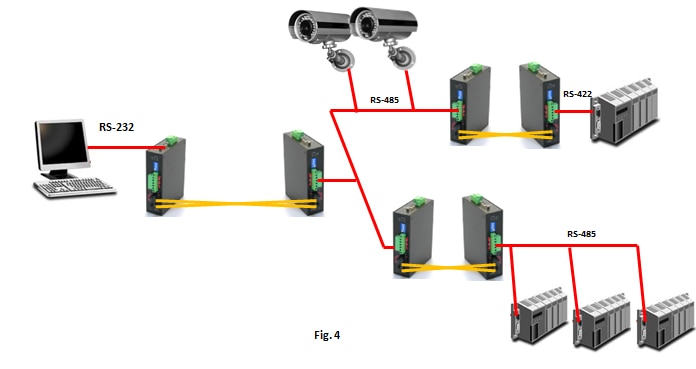
Two Unit Point-to-Point Connection Mode with Fiber Protection
Some point-to-point applications require two duplex fiber connections to ensure that the serial signals are protected in extremely harsh environments (Figure 5).
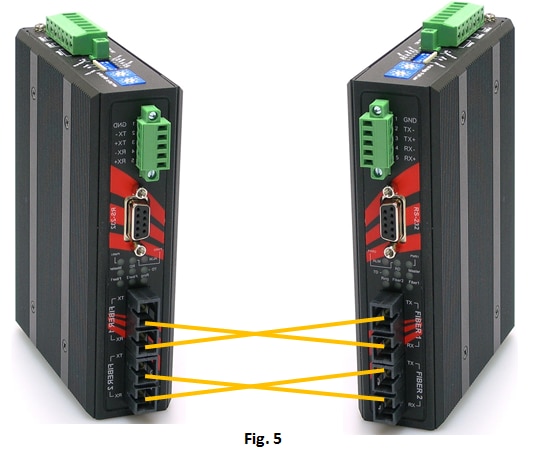
Left Unit: Master & Right Unit: Slave
Antaira’s STF-502C series is a “dual fiber port” version. Users can set one STF-502C unit as a 'master', and the other unit as a 'slave'. The RS-485 and RS-232 are electrically isolated. A receive signal can only be connected to either the RS-485 (terminal block) or to the RS-232 DB9 (not both at the same time). That received signal will be transmitted simultaneously on every transmit connection, both RS-485 and RS-232.
Three or More Units – One Way Daisy Chain Solution
There are quite a few applications that require data transmission to only occur one-way, and the manner of these types of applications requires data that can be transmitted from a remote admin center (control room) to all remote field site devices. Some examples of message display boards in public venues include: rail stations, bus terminals, and warning messages along freeways.
In this application, administrators can use Antaira’s STF-501C single fiber port units for a one-way daisy chain setup network to continuously update any text information from the remote center to multiple stations (Figure 6). 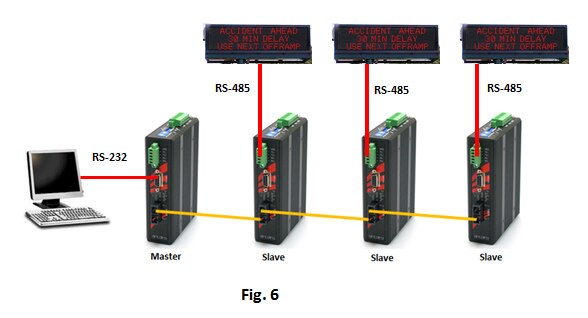
Three or More Units- Daisy Chain Solution
In some applications with three or more units in different locations, a daisy chain solution with duplex fiber protection is required (Figure 7). The RS-485 and RS-232 are electrically isolated. A receive signal can only be connected to either the RS-485 (terminal block) or to the RS-232 DB9 (not both at the same time).
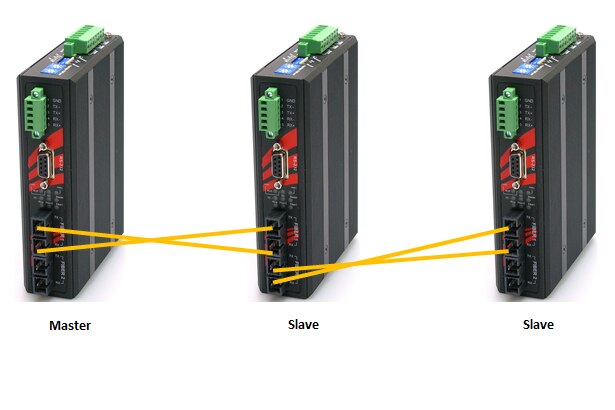
Figure 7
Single Ring Connection Mode with Half Duplex
In single fiber ring topology, the fiber transmit (Tx) of one device connects to the fiber receive (Rx) of the next device. That second device’s fiber transmit connects to the next device’s fiber receive, until a completed ring is formed.
Both Antaira’s STF-401C and STF-501C series completely operates at Layer 1. However, the logic control will ensure that any transmitted data will flow to each device in the ring but it will not loop. The protocol layer is required to handle proper communication flow control. Reception of data at any receive should only be allowed from one device at a time. That received data will then be broadcast (transmitted) to all units and interfaces. In the example to the right, one RS-232 interface receives data and it is broadcast to all other interfaces.
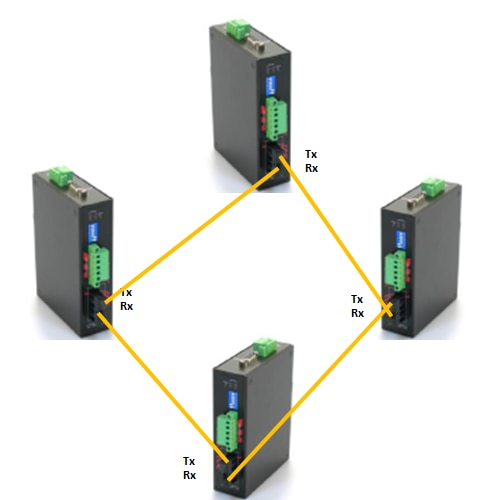
Self-Healing Dual Fiber Ring Connection Mode with Full Duplex
Some critical applications require a zero data loss solution within the serial network because the single ring fiber mode with half duplex provides no redundancy. In the event of a fiber link loss, or a powered off device, 2-way transmission between the devices will not be possible. Depending on where the link is broken, there still may be transmit or receive paths between some devices.
Antaira’s STF-502C series provides a dual fiber port solution, in order to allow users to perform a “self-healing” redundant ring serial fiber network to ensure “zero data lost” protection. The figure to the right demonstrates how to setup a dual ring serial fiber network with Antaira’s STF-502C series.
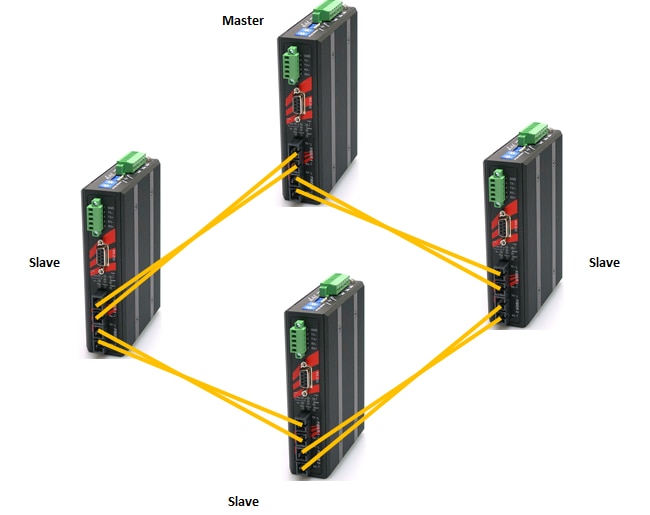
Serial Fiber Connection Mode Comparison
Point-to-point connection mode is a simple bus topology setup, but may require more media converter units when there are multiple serial lines that require connection with the system.
- Available Antaira models include:
o STF-401C series- Compact industrial RS232/422/485 serial fiber converters
o STF-501C series- Industrial RS232/422/485 serial fiber converter with isolation protection.
Single ring connection mode is recommended when multiple serial lines require connection to a system and it requires fewer media converter units and reduces the total length of required fiber cable.
*** When using a ring structure, the maximum length of the fiber cable is up to 100 km
- Available Antaira models include:
o STF-401C series- Compact industrial RS232/422/485 serial-to-fiber converters
o STF-501C series- Industrial RS232/422/485 serial fiber converter with isolation protection.
Dual ring connection mode is recommended whenever there are applications with extreme environmental concerns. Antaira’s STF-501C series provides dual fiber ports to perform a “self-healing” redundant serial fiber network solution. It also has a built-in high surge and optical isolation protection to secure serial data signals.
Product Comparison Chart
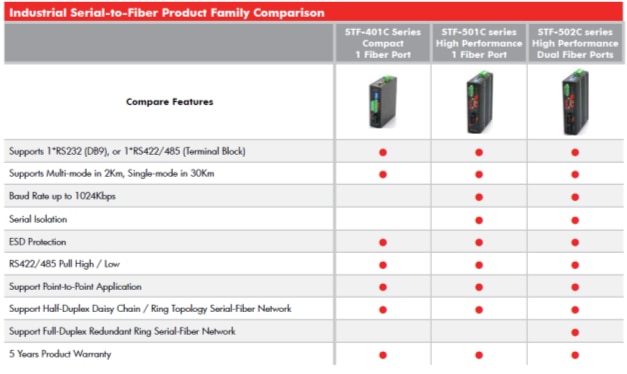
|
|
|
|